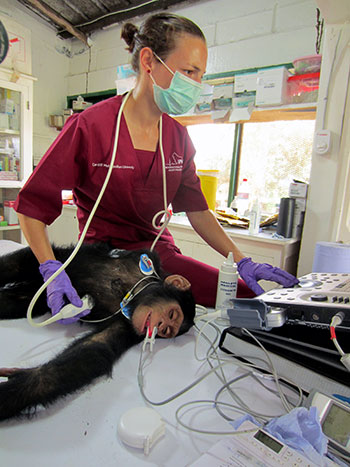UBC research goes from the athletic stadium to African wildlife sanctuaries
An international research group at UBC, Harvard University, and Cardiff Metropolitan University has discovered how the human heart has adapted to support endurance physical activities.

Chimpanzee echocardiogram being performed by Aimee Drane from the International Primate Heart Project. Photo courtesy of Robert Shave.
This research examines how the human heart has evolved and how it adapts in response to different physical challenges, and will bring new ammunition to the international effort to reduce hypertensive heart disease – one of the most common causes of illness and death in the developed world.
The landmark study analyzed 160 humans, 43 chimpanzees and five gorillas to gain an understanding of how the heart manages different types of physical activity. In collaboration with Harvard University’s Daniel Lieberman and Aaron Baggish, UBC Professor Robert Shave and colleagues compared left ventricle structure and function in chimpanzees and a variety of people, including some who were sedentary but disease-free, highly active Native American subsistence farmers, resistance-trained football linemen and endurance-trained long-distance runners.
The wide variety of participants were specifically recruited to examine cardiac function in an evolutionary context. From the athletic stadium to wildlife sanctuaries in Africa, the team measured a diverse array of cardiac characteristics and responses to determine how habitual physical activity patterns, or a lack of activity, influence cardiac structure and function, explains Shave.
“While apes showed adaptations to support the pressure challenge associated with activities such as climbing and fighting, humans showed more endurance related adaptations,” says Shave, director of UBCO’s School of Health and Exercise Sciences.
Guiding their inquiry is the well-known idea that the heart remodels itself in response to different physiological challenges, he notes.
“Moderate-intensity endurance activities such as walking and running stimulate the left ventricular chamber to become larger, longer and more elastic—making it able to handle high volumes of blood,” he says. “But pressure challenges like chronic weight-lifting or high blood pressure, stimulate thickening and stiffening of the left ventricular walls.”
Among humans, the research team showed there is a trade-off between these two types of adaptations. This trade-off means that people who have adapted to pressure cannot cope as well with volume and vice versa. Basically, the hearts of endurance runners aren’t great at dealing with a pressure challenge, and the weight lifter’s heart will not respond well to increases in volume.
This new research provides evidence that the human heart evolved for the purpose of moderate-intensity endurance activities, but adapts to different physical (in)activity patterns.
“As a result, today’s epidemic of physical inactivity in conjunction with highly processed, high-sodium diets contributes to thicker, stiffer hearts that compromise the heart’s ability to cope with endurance physical activity, and importantly this may start to occur prior to increases in resting blood pressure,” explains Shave.
This is often followed by the onset of high blood pressure and can eventually lead to hypertensive heart disease.
“We hope our research will inform those at highest risk of developing hypertensive heart disease,” says Shave. “And ensure that moderate-intensity endurance-type activities are widely encouraged in order to ultimately prevent premature deaths.”
This research was published today in the Proceedings of the National Academy of Sciences journal.